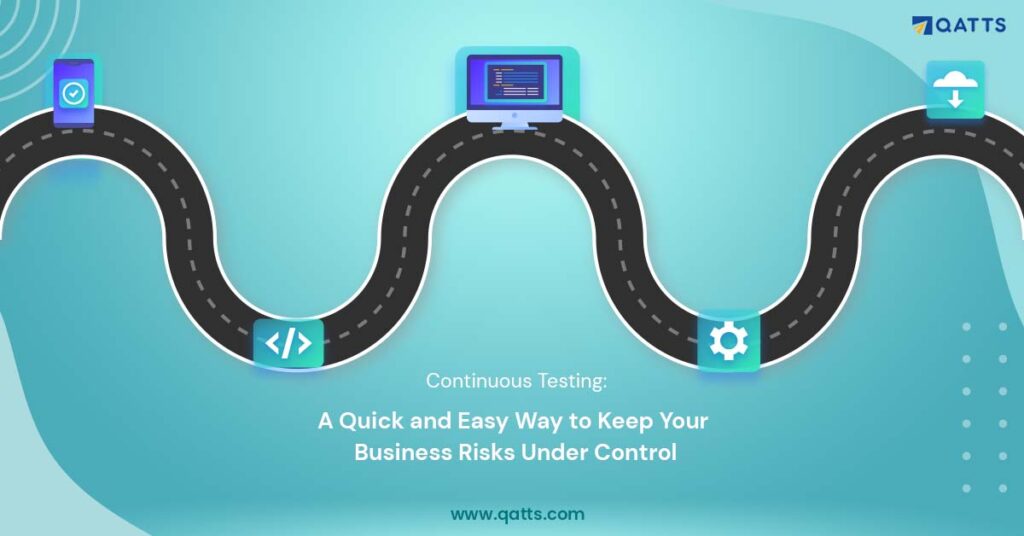
In every organization, quality software is a key enabler for the growth of their business since software connects businesses with their customers. Poor UX and failure of software indicate business risks. To avoid risks and stay competitive, quality software and faster product releases must go hand-in-hand. It is possible if organizations avail of unparalleled software testing services.
Presently, Continuous testing in Agile is gradually becoming a must-have for software testing companies aiming to roll out new features quickly while maintaining a consistent UX and promoting their brand. It helps to minimize business risks and negative impacts on the users. If you do not make this an integral part of your quality assurance testing strategy, there is a chance to increase the risk of delivering faulty software to the market.
What is Continuous Testing actually?
It is the practice of testing across every activity of the software development life cycle (SDLC) to identify and rectify quality changes as they occur. It is implemented as a suite of automated performance, regression, and other tests that run as part of the CI/CD process. In other
terms, it is a procedure of testing early, testing regularly, testing everywhere, and automating.
Is it mandatory to test at each stage of SDLC?
Yes, it is!.
Here are the key benefits of continuous testing and how it keeps any type of business risk under control.
Key benefits of continuous testing:
When executed correctly, continuous testing delivers major business benefits and drives business risks away.
1. Quality, Accuracy, and Speed are the key benefits of Continuous Testing.
- It ensures all errors are found and rectified before it is going live thus ensuring quality.
- It breakdowns the silos among the development, testing, and operations teams thus ensuring transparency in communication and coordination among them and accuracy in results.
- It helps to run parallel performance tests without queues thus it increases testing execution speed
2. It tests in-depth and assures that all aspects of the UX are maintained and acknowledged.
3. Continuous testing boosts test coverage. Because the tests are automated and run from the beginning of the development process. So, it ensures that every potential failure is covered and assesses all features.
4. It enables faster and frequent releases. The code is tested thoroughly and continuously when tests are automated enabling the development teams to deliver reliable results at a greater speed. This results in a faster time to market.
5. Helps in assessing business risk coverage.
6. Reduces the downtime taken for feedback and code review. At each stage, feedback needs to be instant. Continuous testing provides quick and actionable feedback and encourages more coordination between the development and testing teams. The quicker and more detailed the feedback, the more information your team gets so that they can identify and fix critical bugs or defects and improve the application.
7. Continuous testing can reduce the costs of fixing defects. As we all know, when the test code changes, applications are prone to errors. However, continuous testing ensures faster turnaround time and error-free outputs as it identifies and rectifies errors at the early stages of SDLC
itself. Besides, fixing errors after development is more expensive than fixing them in the early stages. Thus, continuous testing reduces the overall costs of resolving bugs and errors.
8. Provides more stable UX. As it finds and rectifies the errors and faults beforehand, the faulty code won’t reach users of your application. They receive intuitive UI/UX. Now, software developers can roll out new features without disrupting the UX.
The right tool integration is the key to success!
On the other hand, continuous testing can be complicated. To make this process easier, quicker, comprehensive, and effective, QA teams must adopt the right automation testing tool. The tool they choose can minimize mundane operations and manual overhead. Qatts is the right continuous testing and automation testing tool for your agile teams.
- It offers a comprehensive platform to perform both manual and automated testing for API, Web, desktop, and mobile.
- It provides the market’s best unified DevOps continuous testing solution that includes streamlined test creation, scalable test execution, cloud-based test labs, advanced analysis, etc.
Conclusion:
In a nutshell, continuous testing at every stage of software development can reduce business risks and help companies to deliver high-quality and modern code.
So, keep your software updated for your frequent releases by incorporating continuous testing best practices. It helps you achieve continuous quality and improvement thus enabling your teams to accelerate release cycles, reduce risks, and lower the costs in this highly competitive world.
Wait not!. Make Qatts as your software testing services partner, continuous testing an integral part of your QA strategy, and reap benefits.


